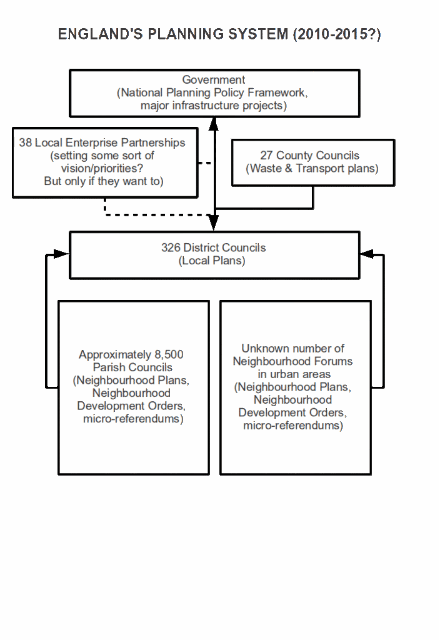Pursuant to this, I've been digging through the Localism Act, which received royal assent on the 15th November. Are you feeling more local yet? Relative to the rumpus about the draft National Planning Policy Framework, the Localism Act hasn't received much attention in the press. This is interesting, as in planning terms it is much more powerful. It has the force of statute, whereas the NPPF will only be policy and therefore possible to overrule depending on the circumstances. Laws are also far more difficult to dislodge than policy, once enacted.
The Localism Act isn't just about planning, and another post will likely be devoted to a tirade about its housing sections. However, it does fundamentally change the way plans will be made and planning applications determined. Every government in the past half century seems to have made similarly seismic changes, so I'm sure the planning profession will do their best to roll with all the new acronyms. When trying to make sense of the structural changes, I found it useful to construct diagrams*. Sorry, they aren't colourful. In an attempt at clarity, I've missed off various bodies that exist (or did) here and there but aren't (or weren't) ubiquitous, like Urban Development Corporations, London Mayors, Local Enterprise Zones, and the like. Unitary authorities are bundled in with district councils.
This is how planning policy-making was:

All very hierarchical, don't you think? This is how it is now:

Note the direction of the arrows, as this indicates who overrules who. During the Labour years, Local Development Frameworks had to be compatible with Regional Spatial Strategies. Now, Neighbourhood Plans will override Local Plans, which are merely re-labelled Local Development Frameworks. The Neighbourhood Plan has to be adopted by a local referendum first, though.
Am I the only who thinks that the new system looks potentially a little chaotic? I speculated on what the hell the draft bill thought it was doing with neighbourhoods a little while ago. Neither I nor, I suspect, anyone else has any idea how many Neighbourhood Forums there might be, or how neighbourhood referendums might work in practise. The legislation gives no limits as to the minimum or maximum geographic size of a 'neighbourhood'. Given the assumption that Parish Councils will serve the same purposes in rural areas, the easiest urban comparison would seem to be electoral wards. London has 624 of these and Cambridge 14. That's a lot of plans, and there is no requirement for them to be consistent.
As for how individual planning applications are determined, the 2004-2010 way was as follows:
Planning applications are determined in accordance with the development plan unless material considerations, such as national policies, characteristics of the site, and local opposition, indicate otherwise. (Paraphrasing the heavily-amended Section 70 of 1990 Town and Country Planning Act and the 2004 Planning and Compulsory Purchase Act)
From now on we will do it like this:
Planning applications are determined with regard to the development plan, presumably the Neighbourhood Plan as that overrides the Local one, material considerations, and any local financial considerations relevant to the application. There's also the presumption in favour of sustainable development, although that's in the (currently draft) National Planning Policy Framework rather than statute and therefore would just be a material consideration. 'Any local financial considerations' could include the meagre New Homes Bonus that Local Authorities get when new homes are built; it could potentially also include the financial impossibility of a Local Authority providing sufficient infrastructure to support a proposed new development as a result of CLG cutting their block grant by 20%. (Paraphrasing Section 143 of the Localism Act)
If I had a more mercenary** twin, they would be a planning lawyer, leafing through yacht catalogues in the expectation of an explosion in lengthy planning appeals. If you are in fact a planning lawyer, then good luck in this neighbourhood morass and please consider donating a portion of your fees to support unemployed former public servants.
* Thank you, OpenOffice.
** Evil seems rather strong; I've met some very pleasant planning lawyers.
No comments:
Post a Comment